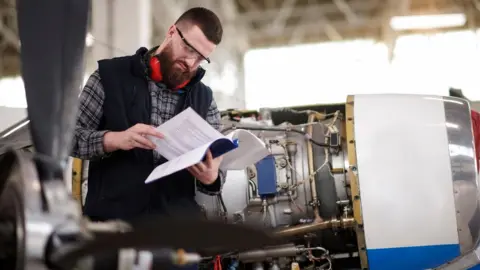
 Getty Images
Getty ImagesWhen you last bought a new electronic device did you look at the instruction manual?
If your answer is a resounding “no”, then you are not alone.
Studies show that many of us don’t bother to read the user guide.
One UK survey found that one in five of us skips the manual, while a US report said it was as high as 50%.
Caspar Herzberg, boss of UK industrial software firm Aveva, says he likes a good instruction manual. “I’m a big fan of mundane things!” But he understands that many people immediately throw them in a kitchen drawer, never to be read.
Yet while it’s OK for a consumer to skip the user guide, this isn’t the case in the world of industry, where engineers have to know exactly how the machinery or computer system they look after works. This is especially the case if a problem arises that they need to fix as quickly as possible.
To help such workers, Aveva has launched an AI system that can read and learn operating manuals on their behalf.
In its first incarnation this AI has memorised the technical manuals for the power grids and wind turbines managed by Aveva’s parent company Schneider Electric.
It also continuously monitors the machinery via thousands of sensors.
The idea is that the AI can imitate the expertise of senior engineers with decades of practical know-how behind them.
So how can the AI assist an energy sector worker who is trying to hunt down the cause of a fault?
Simon Bennett, Aveva’s head of AI innovation, says the AI can locate where there has been, say, a power failure. It then delves into “a monster PDF manual”.
From this, the AI – via a computer screen – generates different ideas of what the problem might be.
It can also produce a 3D image of the affected machinery, such as a turbine, with Mr Bennett noting that engineers appreciate such visual responses to their questions.
Aveva calls the system its “industrial AI assistant”, and says the aim is that it will help to compensate for a dilemma facing many businesses – an ageing workforce that is retiring and taking its hard-earned knowledge with it.
So if someone is new to their job, says Mr Herzberg, “the AI can guide them… and look at the manual for you”.
Or as Mr Bennett puts it: “By asking smart questions of the AI system we won’t have to wake up some old, retired engineer in the night and keep him on the phone for an hour.”
 Getty Images
Getty ImagesWhile Aveva has made an AI system that can search through instruction manuals, other technology companies have created AI that can make such product guides in the first place.
California-based tech firm Dozuki is one such firm. Its AI-powered system CreatorPro can automatically create a user guide based on an engineer making a video of him or her talking through and carrying out a process.
“The user uploads the video, and a step-by-step instruction guide is automatically created,” says Allen Yeung, Dozuki’s vice president of product. “The AI chooses the text that accompanies each step, and it can automatically translate that into other languages.”
Currently the AI produces video clips accompanied by text for other workers to read. Mr Yeung says that they are working to extend the text to speech, with the AI in the future also dictating the instructions via a computer speaker.
The AI-created user guides still, however, need to get signed off by a human being. “The user guides are exported in a draft state for an engineer to review,” says Mr Yeung.
Echoing points made by Aveva, Mr Yeung adds that Dozuki’s product aims to help firms cope with the fact that manufacturing sector workforces are getting older, with more elderly staff retiring.
 Getty Images
Getty ImagesSCG Chemicals, a Thai petrochemicals company that is now due to start using Aveva’s AI, says it is being impacted by an ageing workforce.
“Younger engineers go to an expert when they have a problem, but many of our experienced people are retiring in the next five years,” says divisional director Warit Krittaphol. “We cannot build a pipeline of experts. We have over 14 million documents in our system. AI will be able to grab the right information fast.”
Back in California, Scribe is another tech firm that allows companies to automatically create AI user guides. In Scribe’s case the AI makes the manuals from what a user has done on his or her computer.
“The way the technology works at a simple level… you click the record button, and you do a process you would have normally done anyway, the way you would normally do it,” says Scribe chief executive Jennifer Swift.
“And then when you’ve done doing your work you hit stop record and it will automatically generate a step-by-step written guide with screen shots, instructions, titles etc, showing how to do that process.
“You as an individual have a whole bunch of control over how you can edit it, add lots of content, but the point is you don’t have to. All the information that someone would need to do that same process is automatically contained in that step-by-step guide.”
Stuart Duff, a UK business psychologist who describes his role as “working with people to understand how they behave in a workplace”, thinks that AI can offer a valid short-cut for even the best engineer.
He points out that engineers are no different from the rest of us when it comes to thumbing through a manual.
“Most will be more familiar with detailed manuals and, therefore, more practised and patient at referencing information,” he says.
“But personality preferences can also play a part in how engineers use manuals. Some engineers will be bigger-picture in their thinking style, and will tend to rely on others for specific information, so AI could offer a source of essential detail with easy and efficient access.”



Be the first to comment